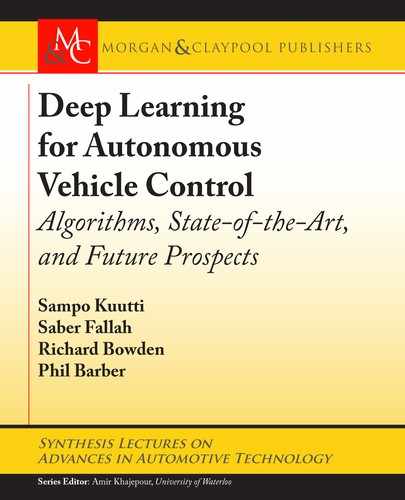4.1. VALIDATION TECHNIQUES 35
of the system. Actuator safety cages are focused on safety-related actuators which influence
the vehicle’s lateral or longitudinal dynamics. Functional safety cages are focused on specific
functions of the vehicle such as automatic parking or overtaking. By defining specific domains
for each safety cage, the safety cages can be tailored to that domain. A further benefit of this
architecture is that it introduces functional safety cages with low complexity that oversee each
function of the vehicle. Since these safety cages are more transparent and less complex than the
neural network controllers they would oversee, they can be validated for safety using traditional
safety validation methods such as formal methods supplemented with testing data. erefore,
a high ASIL classification can be given to these safety cages while a low ASIL classification is
given to the neural network controller, thereby shifting the validation burden from the controller
to the safety cages [192].
4.1.4 CROSS VALIDATION
Cross validation is an approach to provide reliability through redundancy [174]. e core idea is
to use an ensemble of diverse neural networks which each independently estimate an output from
the same inputs [193]. e outputs of each network can then be checked against one another
to validate the system output. e validation is therefore designed into the system architecture,
rather than as a separate process. However, the main purpose of cross validation is to increase
confidence in the output, but it does not give full assurance of the system validity since systematic
errors could occur in each of the networks if they are not sufficiently diverse. e use of ensembles
can provide better performance if the diversity of the networks can mitigate the effects of errors.
Since any network will have errors in at least some subset of its input space, diverse networks in
the ensemble offer complementary responses, such that (weighted) averaging of the input can
be used to get a better prediction of the desired output [194]. Alternatively, instead of all of
the networks affecting the final output, the variance in the ensemble outputs could be used to
estimate the uncertainty in the output of the neural network controller.
In order for cross validation to be effective, there must be some diversity in the neural net-
works in the ensemble [195, 196]. Clearly, if each network has the same output for all possible
inputs, no additional information is gained [197]. erefore, some method of creating diver-
sity in the ensemble networks must be found. One approach is to use multiple networks with
different topologies for the same task. However, it may be challenging to define multiple di-
verse network architectures that can provide adequate performance for the given task. Another
approach is to use multiple networks with the same topology, but each trained with different
training data. is has the advantage that one optimal network architecture can be used for the
whole ensemble. However, since each network requires diverse training data, the quantity of
data required is significantly increased. Regardless of the approach for creating diversity, the
performance of each network must be carefully evaluated. While we do want to promote diver-
sity in the outputs of each network, this should not come at the price of significantly reduced
..................Content has been hidden....................
You can't read the all page of ebook, please click here login for view all page.
